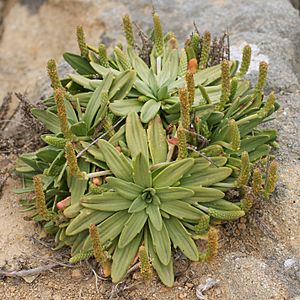Sea plantain facts for kids
Quick facts for kids Sea plantain |
|
|---|---|
 |
|
| Scientific classification | |
| Genus: |
Plantago
|
| Species: |
maritima
|
Plantago maritima, also known as the sea plantain, seaside plantain, or goose tongue, is a type of flowering plant. It belongs to the plantain family, called Plantaginaceae. You can find this plant in many parts of the world, especially in cooler areas and the Arctic. It grows naturally in most of Europe, northwest Africa, northern and central Asia, northern North America, and southern South America.
Contents
What Does Sea Plantain Look Like?
Sea plantain is a plant that lives for many years and has soft stems. Its leaves grow in a tight circle close to the ground, like a rose. These leaves do not have long stalks.
- Each leaf is long and narrow, usually between 2 and 22 centimeters (about 1 to 9 inches) long and less than 1 centimeter (less than half an inch) wide.
- The leaves are thick and feel a bit fleshy.
- They have a pointed tip and their edges can be smooth or have a few small teeth far apart.
- You can usually see three to five veins running through each leaf.
The flowers of the sea plantain are small and greenish-brown, with brown parts called stamens. These flowers grow closely together on a spike, which is like a tall, thin stalk. This spike can be from 0.5 to 10 centimeters (about 0.2 to 4 inches) long and sits on top of a stem that is 3 to 20 centimeters (about 1 to 8 inches) tall.
Different Types of Sea Plantain
There are four main types, or subspecies, of sea plantain:
- Plantago maritima subsp. maritima: This type is found in Europe, Asia, and northwest Africa.
- Plantago maritima subsp. borealis (Lange) A. Blytt and O. Dahl: This one grows in Arctic regions. All its parts are smaller compared to the plants found in warmer areas.
- Plantago maritima subsp. juncoides (Lam.) Hultén: This type is found in South America and North America.
- Plantago maritima subsp. serpentina (All.) Arcang.: You can find this subspecies in Central Europe, especially in mountains where the soil is rich in a type of rock called serpentine soil.
Where Does Sea Plantain Grow?
In many places, sea plantain grows only near the coast, often in sandy soil. But in some areas, you can also find it high up in the mountains, growing along streams. Scientists have studied how this plant lives and how its body works, especially how it changes when there is more carbon dioxide in the air.
How People Use Sea Plantain
Just like other edible plants found near the sea, the leaves of the sea plantain can be picked and eaten. You can eat them raw or cook them. The seeds of the plant can also be eaten raw or cooked, and they can even be ground into a type of flour.
See also
 In Spanish: Llantén marítimo para niños
In Spanish: Llantén marítimo para niños

